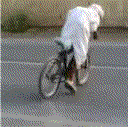There's another effect to trail-braking that helps you get a non-sportbike to turn almost as quickly as a sportbike (again, a sportbike will do it better, but you can make a non-sportbike be pretty good). That's the geometry effect of the forks compressing (swingarm front ends don't do this).
The basic principle at work is that the steeper the front end, the quicker the bike turns in. Sportbikes come that way, cruisers and standards don't. Conversely, the more raked, the more stable it is.
You hear Joe Racer moaning a lot about "My front end dives."
"WELL DUH, JOE!" Of course it dives. Weight transfers to the front end, and the front end goes down. It's physics, it's vehicle dynamics. All fork front ends dive. What Joe Racer doesn't understand is that front end dive can be an advantage, not a problem.
By trail-braking into the corner, the weight transfer on the front causes the forks to compress. When they compress, they shorten. This not only reduces the length of the bike some, so it can turn quicker, but as the front end goes down, it steepens the angle of the forks. So what was a lazy cruiser turns into a much more agile machine when it's under braking.



Now as you accelerate, you get more desirable effects. The front extends as you roll on the throttle, and it goes back to a lazy front end again, so you gain stability and it's less twitchy on exit.
(One thing to be aware of here is that if your bike already has a steep geometry at the front, it can get steeper under braking, which can cause it to get twitchy. Fortunately most steep front ends are on sportbikes, which have suspensions calibrated not to dive as much, and you can also be sure that the designers has this in mind too.)
From TrackDoD Novice Group Orientation



No comments:
Post a Comment